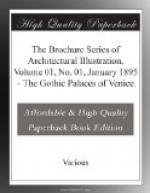This is one of the most notable examples of domestic Gothic architecture in Venice, and dates from the fifteenth century. Ruskin refers to it as follows: “In one respect, however, it deserves to be regarded with attention, as showing how much beauty and dignity may be bestowed on a very small and unimportant dwelling-house by Gothic sculpture. Foolish criticisms upon it have appeared in English accounts of foreign buildings, objecting to it on the ground of its being ‘ill proportioned’; the simple fact being that there was no room in this part of the canal for a wider house, and that its builder made its rooms as comfortable as he could, and its windows and balconies of a convenient size for those who were to see through them and stand on them, and left the ‘proportions’ outside to take care of themselves, which, indeed, they have very sufficiently done; for though the house thus honestly confesses its diminutiveness, it is nevertheless one of the principal ornaments of the very noblest reach of the Grand Canal, and would be nearly as great a loss if it were destroyed, as the church of La Salute itself.”
This building is popularly known as “Desdemona’s House.”
III.
The Palazzo Cavalli, Venice.
This palace, situated opposite the Academy of Arts on the Grand Canal, also dates from the fifteenth century. Its balconies and tracery are of the later Gothic period, showing marked tendencies towards the Renaissance.
It has been recently restored by its present owner, Baron Franchetti, and is frequently spoken of as the Palazzo Franchetti.
IV.
Window tracery in the Palazzo Cavalli.
In Venetian tracery it will always be found that a certain arrangement of quatrefoils and other figures has been planned as if it were to extend indefinitely into miles of arcade, and out of this colossal piece of marble lace a portion in the shape of a window is cut mercilessly and fearlessly: what fragments and odd shapes of interstice, remnants of this or that figure of the divided foliation, may occur at the edge of the window, it matters not; all are cut across and shut in by the great outer archivolt. This is of course open to serious criticism as construction, but its beauty and effectiveness, as used here, cannot be gainsaid.
V.
Window tracery in the Palazzo Cicogna, Venice.
This is an example of early Gothic work in Venice and is quite unlike later examples. Ruskin speaks of it as the only instance of good complicated tracery to be found in Venice. The fact that it is moulded only on the face is considered evidence of its early date.
In this view, as, in fact, in all of the examples which we have selected, the moulding formed of alternating blocks or dentils, projecting first on one side and then the other, which is peculiar to Venice, can be seen. It was commonly used as a frame about a window or group of windows, and is very effective, especially when used, as it frequently was, relieved against a flat wall surface.




